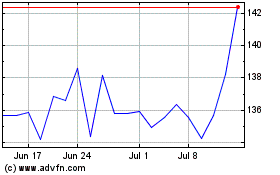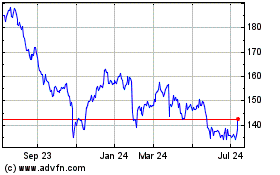Wal-Mart Stores Inc. is testing a two-day shipping subscription
service and building a regional delivery network, in the boldest
attempt yet by a major traditional retailer to compete head-on with
Amazon Prime.
As part of the project, Wal-Mart, the world's biggest retailer,
will shift more inventory to eight massive e-commerce warehouses
around the U.S., the last of which will be built by year's end. It
is part of a $2 billion investment the company is making in
technology and logistics to boost e-commerce sales.
The company will also put its major transportation fleet and
logistics know-how up against Amazon.com Inc. as it makes a play to
meet Amazon on its own turf. Wal-Mart will tap regional carriers to
deliver more of its packages, according to people familiar with the
project. But it will also use its 6,000 tractor-trailers, one of
the largest private trucking fleets in the country, along with its
4,600 U.S. stores, to take on what has become one of its biggest
rivals.
That could make Wal-Mart less reliant on FedEx Corp., which
handles the bulk of Wal-Mart's parcels. FedEx declined to
comment.
As more shopping shifts online, Wal-Mart is reallocating
capital. Earlier this year it closed more than 150 U.S. stores, in
part to free up resources to invest in its e-commerce offerings. It
has been investing heavily in a program that lets people order
groceries or household goods on its website for curbside pickup at
stores, a program executives have touted as a key way to compete
with online-only retailers.
Meanwhile, Amazon has been expanding into new categories like
groceries and fashion, and raising consumer expectations for ever
faster delivery to their homes. It uses its $99-a-year Prime
program to keep shoppers loyal by linking more benefits to
membership, like access to movie streaming and discounts. Analysts
estimate Prime has signed up more than 50 million members
world-wide and that such customers spend about twice as much money
on Amazon.com a year than non-Prime customers.
Last year Wal-Mart began experimenting with a three-day shipping
service for members who pay $50 a year. The program, called
"ShippingPass," is similar to Prime, which provides free two-day
shipping.
In February, Wal-Mart invited several regional carriers to a
conference in Atlanta where it outlined its vision of building a
network of regional delivery companies and solicited bids,
according to the people familiar with the plans. Wal-Mart wooed the
carriers with promises of steady streams of package volume and a
strategic partnership, these people said.
At the conference, Wal-Mart told attendees it planned to use its
sprawling transportation network to conquer e-commerce. Trucking
more of its own packages closer to the shipping destinations for
what's known as last-mile delivery would allow the company to save
on one of the higher-cost elements of shipping a package across the
country.
"It's a big initiative to drive their e-commerce business,"
including heavy investments, said one of the attendees. "I know
they're very serious about this."
Starting Thursday, ShippingPass members will get free two-day
shipping for $49 a year, said a Wal-Mart spokesman. He declined to
say how many people have signed up for the service, which is only
available by invitation. Standard delivery on Walmart.com can take
around a week and the company typically charges for shipping orders
less than $50.
Other retailers have tried to answer Amazon's aggressive
expansion. Target Corp., for example, gives free shipping to
customers who pay with its loyalty credit or debit cards, while
online retailer Overstock.com Inc. has a $20-a-year free shipping
program. Others chains, including Toys "R" Us Inc., Saks Fifth
Avenue and Staples Inc., have teamed up with ShopRunner Inc., a
$79-a-year service that offers free two-day shipping from dozens of
merchants. EBay Inc., too, is experimenting with an unlimited
two-day shipping program in Germany.
But Wal-Mart has one of the best chances to truly take on and
compete with Amazon, said Ivan Hofmann, a former FedEx executive
and transportation industry consultant. "They know transportation
better than people realize," said Mr. Hofmann. "It's a core
strength of Wal-Mart."
Its truck fleet is one of the five largest private fleets in the
country, according to Satish Jindel, president of industry tracker
ShipMatrix. And a large part of Wal-Mart's success is its ability
to move all those products cheaply and efficiently around the
country.
To achieve the two-day shipping window and shorten delivery
times generally, Wal-Mart is, in part, looking to regional delivery
companies. These firms typically ship only within a handful of
states and can charge rates as much as a third lower than those of
national carriers like FedEx and United Parcel Service Inc.
Since 2014, Wal-Mart has poured billions into beefing up its
supply chain and technology to increase online sales, which
increased 12% to $13.7 billion for the fiscal year ended Jan. 31.
Despite the investment, Wal-Mart's global e-commerce sales slowed
each quarter of last fiscal year. Executives said weak
international results were partially to blame. Amazon, meanwhile,
clocked a 17.5% increase to $99.1 billion in online and
electronic-device sales in 2015.
E-commerce has turned out to be more expensive than many
retailers expected. They still struggle to make a profit shipping
low-cost items such as tubes of toothpaste, boxes of pasta or socks
to people's homes.
Amazon sends out about seven times the number of packages
Wal-Mart does in North America, according to ShipMatrix estimates.
That means Amazon will almost always get better rates than Wal-Mart
with delivery companies. Amazon is already a major customer of the
regional delivery companies that Wal-Mart plans to use more
frequently.
Currently, Wal-Mart's e-commerce operation relies on more than
150 distribution centers that help serve the eight large e-commerce
fulfillment centers. Over 80 of its U.S. stores are set up to act
as delivery hubs.
Greg Bensinger
Write to Laura Stevens at laura.stevens@wsj.com and Sarah
Nassauer at sarah.nassauer@wsj.com
(END) Dow Jones Newswires
May 12, 2016 20:05 ET (00:05 GMT)
Copyright (c) 2016 Dow Jones & Company, Inc.
United Parcel Service (NYSE:UPS)
Historical Stock Chart
From Mar 2024 to Apr 2024

United Parcel Service (NYSE:UPS)
Historical Stock Chart
From Apr 2023 to Apr 2024
